The 30 Best Places to Live in Idaho: Top Cities and Towns

Idaho offers a diverse range of communities that cater to different lifestyles, budgets, and preferences across its varied landscape.
From bustling state capitals to quiet mountain towns, the state provides options for families, young professionals, retirees, and everyone in between.
This comprehensive guide examines thirty of Idaho’s most livable cities and towns, evaluating factors such as affordability, amenities, job opportunities, and quality of life to help prospective residents make informed decisions.
The analysis covers major metropolitan areas, growing suburban communities, and smaller towns that offer unique advantages for those seeking a different pace of life in the Gem State.
Here are the 30 best places to live in Idaho:
30. Kuna
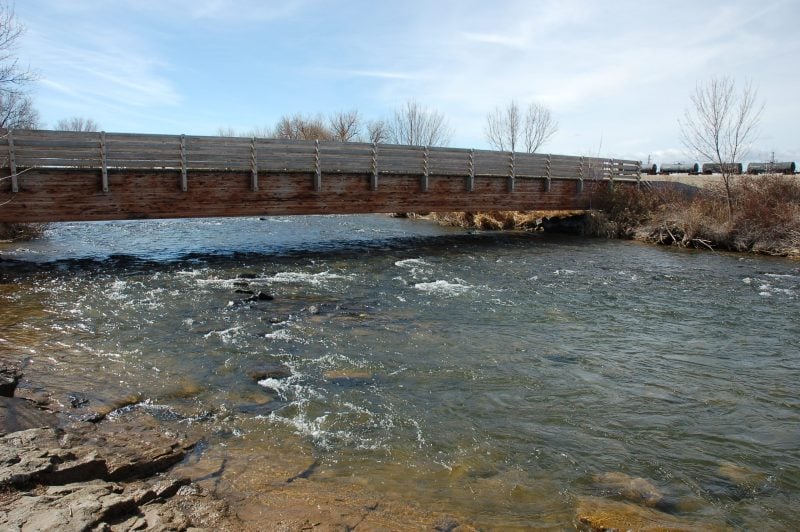
Kuna is a growing city in Ada County with a population of approximately 25,960 residents. The community offers a rural atmosphere while maintaining proximity to larger urban centers.
The city provides residents with affordable housing options and a family-friendly environment. Most residents own their homes, contributing to neighborhood stability.
Kuna features excellent public schools that attract families seeking quality education for their children. The local school system maintains strong academic standards.
The area offers access to outdoor recreational activities and maintains low crime rates. Residents enjoy a safe community environment with various local amenities.
Employment opportunities exist primarily in nearby metropolitan areas. The city attracts both families and young professionals seeking a quieter lifestyle.
Local attractions include the Mary Ellen McKee Historical Museum and proximity to the Discovery Center of Idaho. These facilities provide educational and cultural experiences for residents.
29. Emmett
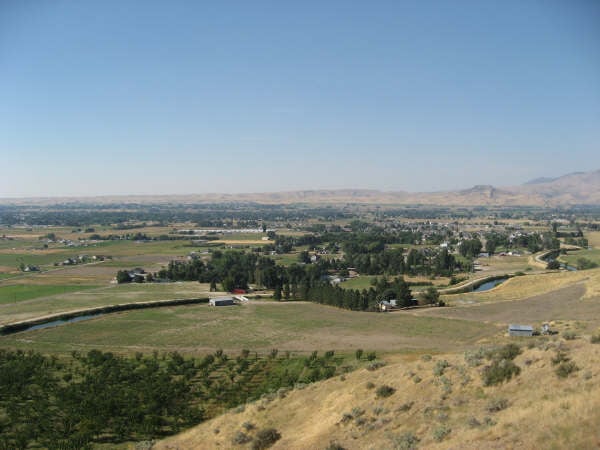
Emmett sits in Gem County with a population of approximately 6,557 residents. The city offers a cost of living that runs 0.6% below the national average.
Residents describe the community as friendly and supportive. The people are known for their willingness to help neighbors in need.
Emmett ranks among Idaho’s more conservative cities. This political climate appeals to residents seeking traditional values and small-town governance.
The area features scenic landscapes typical of southwestern Idaho. Natural beauty surrounds the community with rolling hills and open spaces.
Housing costs remain affordable compared to many Idaho cities. The cost of living score of 99.4 makes Emmett accessible for various income levels.
The city maintains a small-town atmosphere while providing essential amenities. Emmett offers a slower pace of life away from urban centers.
28. Jerome
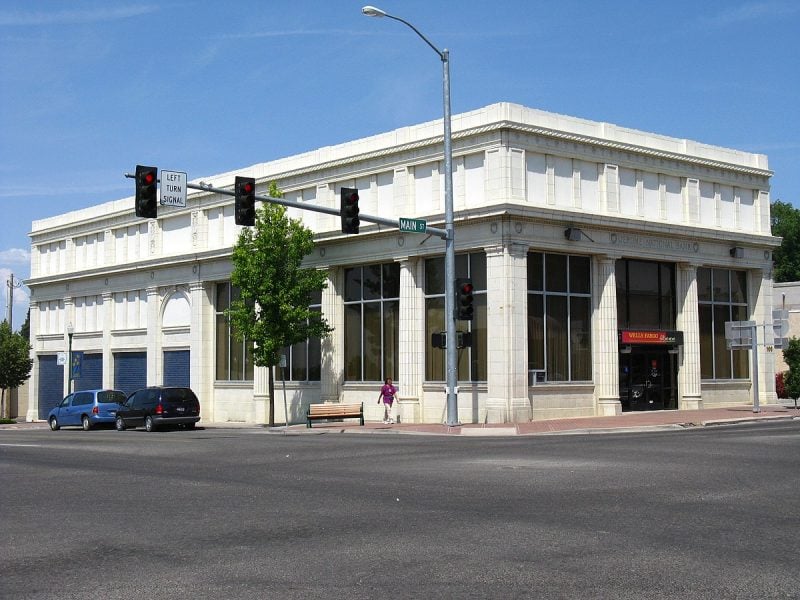
Jerome sits in south-central Idaho, approximately 130 miles southeast of Boise. This small city offers residents a quiet, family-friendly atmosphere with a population that fosters close community connections.
The cost of living in Jerome remains affordable compared to many Idaho cities. Home prices fall below the state average of $281,471, making homeownership accessible for many families.
Jerome provides access to outdoor recreation through nearby attractions. Bruneau Dunes State Park offers unique desert landscapes, while Shoshone Falls creates opportunities for sightseeing and exploration.
The city hosts the annual Liberty Bank Music Fest each June. This event celebrates traditional music and brings the community together for entertainment.
Jerome’s location provides convenient access to Twin Falls and other regional amenities. The small-town environment appeals to those seeking a slower pace of life while maintaining connections to larger urban centers.
27. Bonneville

Bonneville County ranks among Idaho’s most livable areas, scoring particularly well in affordability and safety metrics. The county offers residents a balanced combination of essential amenities and educational access.
Home prices in Bonneville County align closely with Idaho’s state average of $281,471. This pricing structure makes homeownership accessible for many residents seeking value in the housing market.
The area attracts people through its strong livability ratings across multiple categories. Safety remains a key factor that draws families and individuals to establish roots in the community.
Educational institutions throughout the county provide quality options for residents. The combination of schools and community resources supports long-term family planning and development.
Bonneville County’s appeal stems from its practical advantages rather than flashy attractions. The area delivers consistent quality of life through reliable infrastructure and community services.
26. Coeur d’Alene North
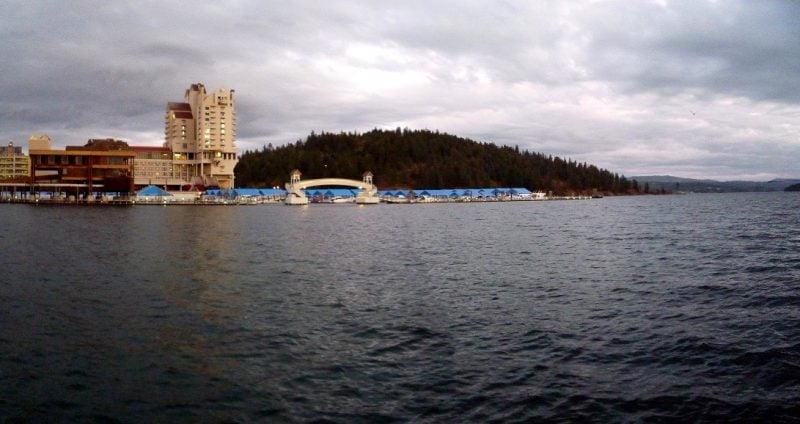
Coeur d’Alene North offers residents proximity to Lake Coeur d’Alene while maintaining a quieter atmosphere than downtown areas. The northern sections provide easy access to recreational activities and natural amenities.
This area features a mix of established neighborhoods and newer developments. Many homes offer lake views or quick access to waterfront activities.
North Idaho College sits in this region, bringing educational opportunities and cultural events. The college presence adds vibrancy while keeping the area family-friendly.
Residents enjoy short commutes to downtown Coeur d’Alene and nearby amenities. The location provides convenience without the bustle of more central areas.
Housing options range from modest family homes to larger properties with acreage. The area attracts families seeking space and outdoor recreation opportunities.
Parks and trails connect throughout the northern sections. These green spaces provide hiking, biking, and walking opportunities for active residents.
25. Chubbuck

Chubbuck ranks as the fourth-best place to live in Idaho according to comprehensive state rankings. This city of approximately 15,900 residents offers a sparse suburban atmosphere where most people own their homes.
The community attracts families and young professionals seeking quality living options. Chubbuck’s poverty rate sits at 10.9%, which falls 22% below the national average.
Home prices in Chubbuck remain more affordable than Idaho’s state average of $281,471. The typical household earns $61,442 annually, slightly below the national median but reasonable for the area’s cost of living.
Public schools in Chubbuck perform above average standards. The city provides residents with low overall living costs while maintaining good quality of life metrics.
Located in Bannock County, Chubbuck offers stability for those seeking suburban living in southeastern Idaho.
24. Ammon
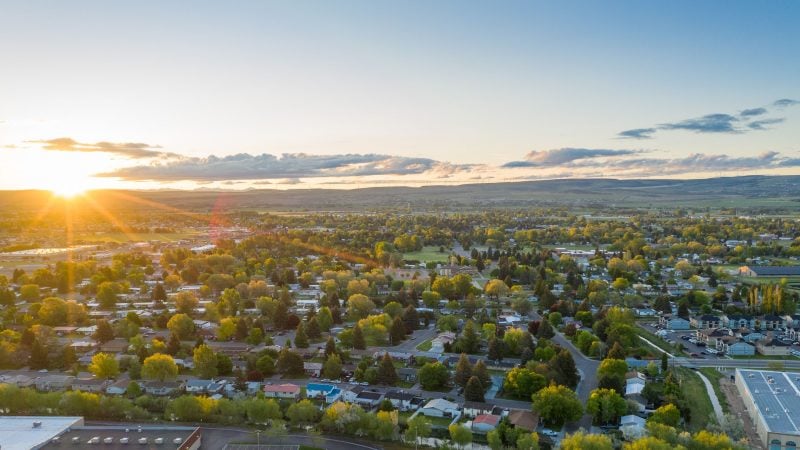
Ammon sits in eastern Idaho’s Bonneville County, just outside Idaho Falls. The city has experienced steady growth while maintaining its small-town atmosphere.
The community offers excellent amenities and recreational opportunities. Residents enjoy access to well-maintained parks and family-friendly facilities throughout the area.
Housing options include newer developments and established neighborhoods. The city attracts families seeking quality schools and safe streets.
Ammon provides easy access to outdoor activities in the surrounding region. The Snake River and nearby mountains offer hiking, fishing, and seasonal recreation.
The local job market benefits from proximity to Idaho Falls’ business district. Many residents commute short distances to employment centers while enjoying Ammon’s quieter residential setting.
The city maintains strong community connections through local events and organizations. Schools receive positive ratings from residents and education professionals.
23. Blackfoot
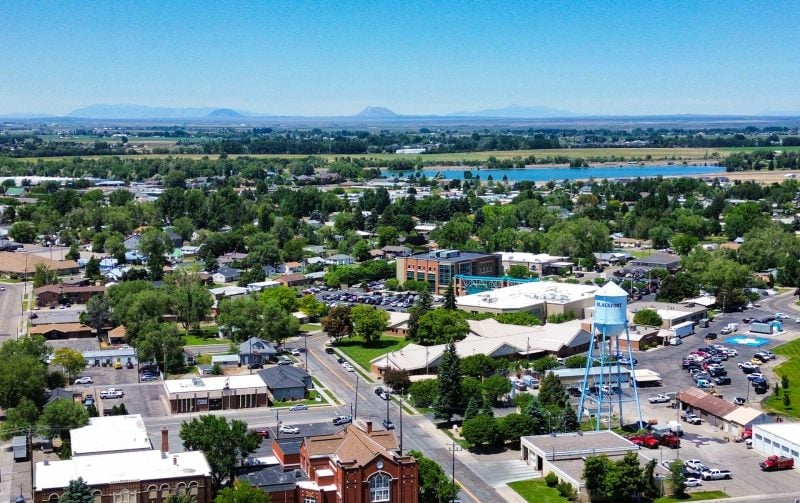
Blackfoot sits in Bingham County in southeastern Idaho with a population of approximately 12,600 residents. The city offers a sparse suburban atmosphere where most residents own their homes.
The community maintains strong western heritage and culture. Blackfoot serves as home to the National Oregon/California Trail Center, attracting visitors interested in historic westward expansion.
Housing costs remain below Idaho’s state average of $281,471, making homeownership accessible for many families. The typical household earns $52,360 annually.
Outdoor recreation opportunities include biking, fishing, golfing, and hiking throughout the area. The city features numerous parks for residents to enjoy.
Blackfoot attracts both families and young professionals seeking a conservative community environment. The poverty rate of 12.9% falls below the national average by 8%.
The city has received recognition as one of Idaho’s better places to live based on factors like cost of living and quality of life metrics.
22. Rexburg

Rexburg sits in southeastern Idaho’s Madison County, home to approximately 29,000 residents. The city hosts Brigham Young University-Idaho, creating a vibrant college town atmosphere.
The community maintains well-kept public parks and offers numerous restaurants and activities. College students contribute to the local economy and cultural scene.
Rexburg provides access to outdoor recreation with Idaho’s natural landscapes nearby. Yellowstone Bear World and the National Oregon Trail Center attract visitors to the area.
The city reflects conservative values and emphasizes family-oriented living. Community events draw strong attendance from residents throughout the year.
Housing costs vary significantly across different neighborhoods within the city. The median household income sits below the national average at approximately $33,000.
Rexburg offers a peaceful small-town environment with educational opportunities and community engagement.
21. Burley
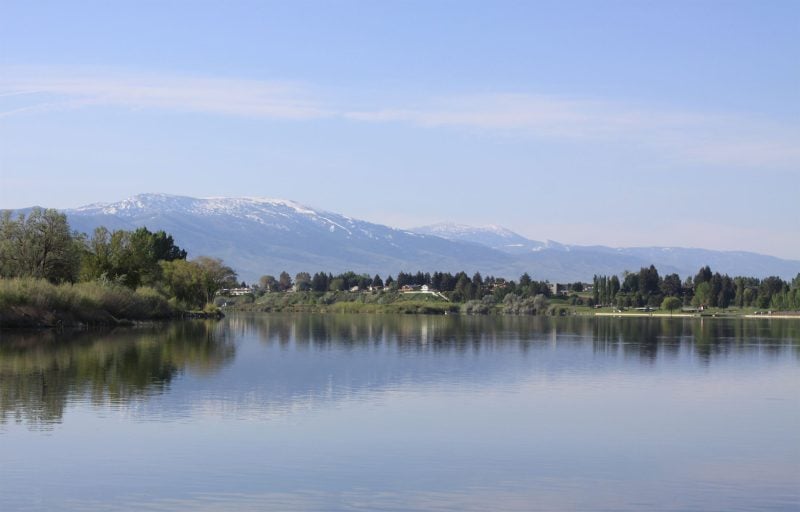
Burley offers residents a welcoming community atmosphere in south-central Idaho. The city has earned a livability score of 73 out of 100, reflecting its overall quality of life.
Housing options in Burley are diverse and affordable. The real estate market provides choices ranging from cozy homes to spacious houses across different neighborhoods.
Crime rates in Burley tend to be lower than many urban areas. The community maintains a safe environment for families and individuals.
The city serves as a regional hub with access to essential amenities and services. Local job opportunities exist, though the economy is primarily driven by agriculture and related industries.
Burley’s location provides access to Idaho’s outdoor recreation opportunities. Residents can enjoy the state’s natural landscapes while living in a stable community setting.
20. Sandpoint
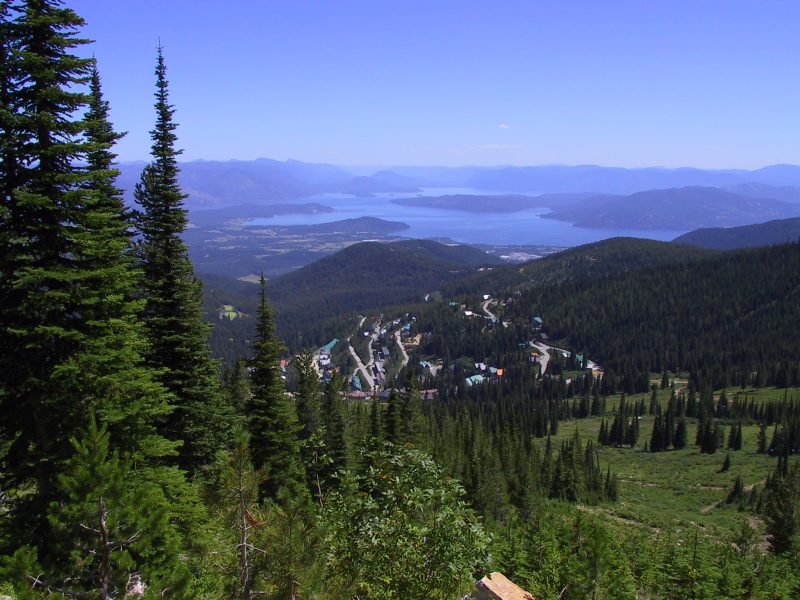
Sandpoint sits in northern Idaho’s Bonner County with a population of approximately 8,385 residents. The city has earned recognition as one of the best places to live in the United States.
Lake Pend Oreille and the surrounding mountains provide scenic views and outdoor recreation opportunities. Residents enjoy year-round activities including skiing, hiking, boating, and fishing.
The local economy has shown steady growth while maintaining the character of a small mountain town. Housing costs exceed Idaho’s state average, reflecting the area’s desirability and quality of life.
Sandpoint ranks 13th out of 69 Idaho communities for public school quality. The city combines small-town charm with access to natural amenities that attract families and retirees.
The downtown area features local businesses, restaurants, and cultural venues that serve both residents and visitors throughout the year.
19. Driggs
Driggs sits in the shadow of the Teton Range in eastern Idaho. The city offers stunning mountain views and access to outdoor recreation.
The community maintains a small-town atmosphere with a population that values the natural surroundings. Housing costs reflect the area’s proximity to Jackson Hole and the Tetons.
Crime rates remain relatively low compared to urban areas. The local economy relies heavily on tourism and seasonal activities.
Political views have diversified in recent years due to the area’s location near Jackson Hole. Environmental and land use issues generate particular interest among residents.
The neighborhoods vary in quality and median home values throughout the city. Real estate prices tend to be higher than other rural Idaho communities.
Driggs attracts residents seeking mountain living with access to skiing, hiking, and other outdoor activities. The area experiences cold winters and mild summers typical of the region.
18. Hailey
Hailey sits in a narrow valley running north-south through the mountains of south-central Idaho. The town serves as a gateway to the famous Sun Valley and Ketchum ski resorts located just above it.
The city attracts residents seeking mountain living with outdoor recreation opportunities. Skiing, hiking, and fishing dominate the local lifestyle during different seasons.
Hailey offers a more affordable alternative to nearby Ketchum while maintaining access to world-class amenities. The town features local shops, restaurants, and cultural events throughout the year.
Housing costs remain lower than neighboring resort communities. This makes Hailey appealing to year-round residents and those working in the tourism industry.
The area experiences four distinct seasons with snowy winters and warm summers. Mountain views surround the valley from all directions.
Hailey provides small-town charm while staying connected to larger recreational and cultural opportunities in the Wood River Valley.
17. Garden City
Garden City sits nestled along the Boise River in southwestern Idaho, surrounded by Boise and Eagle. The small city has gained recognition as one of Idaho’s top places to live.
The area ranks highly for young professionals and retirees alike. It earned the 4th position among Idaho’s best suburbs to live in according to recent rankings.
Garden City serves as a hub for outdoor recreation activities. The Boise River location provides residents with abundant recreational opportunities and scenic natural landscapes.
The city features exceptional craft breweries that draw visitors and residents. Downtown Garden City offers various amenities and maintains a vibrant atmosphere.
Housing demand has increased significantly due to the area’s popularity. Home prices exceed Idaho’s state average, reflecting the desirability of living in this riverside community.
The location provides easy access to Boise while maintaining its own distinct character. Garden City combines small-town charm with proximity to urban amenities.
16. Apple Valley
Apple Valley sits in the southwestern part of Idaho, offering residents a quiet suburban atmosphere. The community features well-maintained neighborhoods with single-family homes at moderate prices compared to larger Idaho cities.
The area provides easy access to outdoor recreation opportunities. Residents enjoy hiking trails and parks within a short drive from their homes.
Apple Valley maintains a family-friendly environment with local schools serving the community. The neighborhood attracts young families and retirees seeking a peaceful living situation.
Shopping and dining options are available nearby, though residents often travel to larger cities for extensive retail needs. The location offers a balance between small-town living and urban conveniences.
The community experiences Idaho’s typical dry climate with cold winters and warm summers. Snow occurs during winter months but rarely reaches extreme levels.
15. Mountain Home
Mountain Home sits in Idaho’s high desert region, home to approximately 14,526 residents. The city has grown alongside Mountain Home Air Force Base, which remains central to the community’s identity and economy.
Housing costs stay reasonable compared to other Idaho cities. The median home price reaches $234,200, below the state average of $281,471. This affordability attracts families and military personnel seeking quality housing options.
The area experiences a comfortable climate with mild winters and warm summers. Residents enjoy access to outdoor recreation opportunities in the surrounding high desert landscape.
Mountain Home maintains a relatively young population with a median age of 30.3 years. The unemployment rate sits at 4.3%, while the median household income reaches $46,836 annually.
The military presence creates a stable economic foundation for local businesses and services.
14. Sun Valley
Sun Valley stands as one of Idaho’s premier mountain resort communities. The town hosts a population of 1,383 residents in Blaine County.
Home prices significantly exceed Idaho’s state average of $281,471. The area attracts young professionals and retirees seeking a high-quality lifestyle.
Residents enjoy a dense suburban environment where most people own their homes. The community maintains a close-knit atmosphere despite its resort town status.
Sun Valley offers excellent outdoor recreation opportunities year-round. Mountain trails and skiing provide residents with direct access to nature activities.
The town features above-average public schools with smaller class sizes. This creates better student-teacher ratios and more personalized attention.
Safety remains a key advantage with notably low crime rates. The area combines small-town security with resort amenities and mountain views.
13. Ketchum
Ketchum sits in the Wood River Valley at the base of the Sawtooth Mountains in Blaine County. The town has a population of approximately 3,551 residents and offers a dense suburban atmosphere.
Most residents own their homes in this mountain community. The area attracts both young professionals and retirees who appreciate the outdoor lifestyle.
Ketchum provides extensive recreational opportunities with miles of trails for hiking, biking, and skiing. The proximity to the Sawtooth Mountains creates access to outdoor activities year-round.
The public schools in Ketchum perform above average compared to state standards. This makes the community appealing to families with school-age children.
The typical household earns around $60,491 annually. The poverty rate stands at 14.6%, which is slightly higher than the national average.
Ketchum receives a livability score of 65 out of 100, ranking in the 63rd percentile among American cities.
12. Moscow
Moscow ranks as one of Idaho’s top destinations for residents seeking a university town atmosphere. The city serves as home to the University of Idaho, earning its nickname as the “Fest City.”
Housing costs remain reasonable with median home prices around $423,000. The cost of living sits 5.3% below the national average, making it affordable for many residents.
Moscow offers a safer environment than 30% of US cities. The crime rate remains relatively low compared to national standards.
The local economy maintains a 6.4% unemployment rate. Job opportunities exist primarily through the university and related sectors.
Transportation requires a vehicle since Moscow scores low on walkability metrics. Most daily activities need car access for convenience.
The city attracts young adults and families drawn to its educational opportunities and small-town charm.
11. Caldwell
Caldwell ranks as the eighth best place to live in Idaho. This Boise suburb sits 28 miles west in Canyon County.
The city offers excellent value with a high cost of living score at #7 out of 12 Idaho cities. Housing costs remain notably low compared to other areas in the state.
Safety ranks highly in Caldwell at #3 out of 12 cities for crime and safety ratings. Residents enjoy a secure environment for living and working.
Shopping options include major retailers like Walmart alongside diverse local businesses. Indian Creek Plaza and the downtown area feature numerous mom-and-pop venues with varied dining options.
Neighborhoods vary significantly in quality and median home values throughout the city. The market shows clear preferences for certain areas based on desirability and property values.
10. Post Falls
Post Falls sits in Kootenai County and ranks among Idaho’s most desirable places to live. The city consistently scores high for quality of life, earning a 7 out of 10 rating for overall livability.
Home prices in Post Falls exceed Idaho’s state average of $281,471. The higher costs reflect strong market demand and desirable neighborhoods.
Residents enjoy abundant outdoor activities and numerous golf courses throughout the area. The city offers good restaurants and maintains low property taxes compared to many other states.
Post Falls provides convenient access to nearby Coeur d’Alene and Spokane for additional entertainment and cultural options. The location appeals to those wanting small-city charm with big-city amenities nearby.
Winter weather brings cold temperatures and significant snowfall to the region. The climate suits those who enjoy seasonal variety and winter sports activities.
9. Lewiston
Lewiston sits at the confluence of the Snake and Clearwater Rivers in north-central Idaho. The city combines small-town charm with outdoor recreational opportunities and a strong sense of community.
The public school system ranks among the best in Idaho. Healthcare services receive high ratings compared to other cities throughout the state.
Lewiston earned a livability score of 72 out of 100, placing it in the 83rd percentile of American cities. The median household income reaches $71,005, while the median property value stands at $353,714.
The homeownership rate sits at 69 percent. Crime rates remain relatively low, contributing to the overall quality of life.
Residents enjoy access to river activities, hiking trails, and outdoor adventures. The close-knit community atmosphere attracts families and professionals seeking a quieter lifestyle while maintaining urban amenities.
8. Pocatello
Pocatello sits in southeastern Idaho at the upper end of the Snake River Valley. The city has a population of approximately 57,000 residents and serves as a college town centered around Idaho State University.
The Historic Old Town district features restored homes and a vibrant downtown area. The University District attracts students and faculty with its proximity to campus amenities.
Pocatello offers residents a sparse suburban feel with numerous parks throughout the city. Most residents own their homes rather than rent.
The city provides access to outdoor recreation activities while maintaining small-city conveniences. Educational opportunities are strong due to the presence of Idaho State University and above-average public schools.
Housing disparity exists across different neighborhoods, with quality varying significantly by area. The city attracts families and young professionals who appreciate the blend of educational resources and recreational access.
7. Eagle
Eagle stands as one of Idaho’s most desirable communities, located just 10 miles northwest of Boise. This affluent suburb combines rolling hillside views with a close-knit community atmosphere.
The city houses approximately 31,490 residents and stretches from the scenic foothills to the Boise River. Eagle offers a sparse suburban feel where most residents own their homes.
Families particularly appreciate Eagle’s highly rated public schools and abundant parks. The community maintains low crime rates and provides excellent recreational opportunities including golf courses and spas.
Home prices in Eagle exceed Idaho’s state average, reflecting the area’s desirability and market demand. The city incorporated in 1971 and has grown alongside neighboring communities like Meridian.
Eagle consistently ranks among Idaho’s best places to live due to its educational excellence, safety, and quality of life. The community tends to lean conservative and attracts residents seeking suburban comfort near urban amenities.
6. Nampa
Nampa stands as Idaho’s third-largest city with nearly 100,000 residents. The city sits in Canyon County within the Treasure Valley region.
Nampa offers strong employment opportunities across various industries. The city has earned recognition as one of America’s best places to live and best cities for families.
Housing costs remain affordable compared to many western cities. Residential developments continue expanding to meet growing demand.
The city provides access to cultural attractions and nature parks. Residents enjoy outdoor recreation opportunities throughout the surrounding area.
Nampa’s location offers convenient access to Boise while maintaining its own community identity. The city balances urban amenities with small-town charm.
Neighborhoods vary significantly in quality and home values across the city. Crime rates tend to be lower in higher-value residential areas.
5. Twin Falls
Twin Falls stands as a vibrant community in south-central Idaho with a population exceeding 45,000 residents. The city draws visitors and residents alike with its spectacular Shoshone Falls, where water cascades dramatically over massive rock formations.
The area offers stunning natural scenery and abundant outdoor recreation opportunities. Residents enjoy access to rugged landscapes and diverse terrain that make the region appealing for nature enthusiasts.
Housing costs in Twin Falls remain below Idaho’s state average of $281,471, making it an affordable option for homebuyers. The real estate market reflects strong neighborhood desirability based on buyer preferences.
Twin Falls sits in Idaho’s Snake River Plain region, known for its dry weather patterns and manageable snowfall. The city provides a balance of natural beauty and community amenities that attract both tourists and permanent residents.
4. Idaho Falls
Idaho Falls stands out as a vibrant city in Bonneville County that recently earned recognition from U.S. News as a top place to live. The city offers residents a dynamic range of living options with affordable housing and access to thriving shopping districts.
Located in eastern Idaho, the community provides easy access to outdoor recreation opportunities. Residents enjoy proximity to Rocky Mountain National Park, Harriman State Park, and the Snake River for various activities.
The city features cultural attractions like the Museum of Idaho and numerous popular restaurants. Idaho Falls neighborhoods vary in quality and median home values, giving residents multiple options based on their preferences and budgets.
This bustling community combines urban amenities with outdoor access. The area attracts people seeking both city conveniences and natural beauty in one location.
3. Coeur d’Alene
Coeur d’Alene sits in northern Idaho along the shores of beautiful Coeur d’Alene Lake. The city offers stunning mountain views and water activities year-round.
This lakeside community ranks #3 nationally for quality of life according to recent data. The downtown area provides urban amenities with direct lake access.
Housing costs have increased significantly in recent years. The city’s cost of living now sits 6% above the national average, making it less affordable than before.
Fernan Lake Village offers lakefront living on the east side with mountain views. Downtown neighborhoods appeal to those wanting walkable urban living near the water.
The city scores well for livability and education. Residents enjoy outdoor recreation including boating, hiking, and winter sports in the surrounding mountains.
2. Meridian
Meridian ranks as one of Idaho’s fastest-growing cities and sits in the desirable Treasure Valley of southwestern Idaho. The city earned recognition as Money magazine’s Best Places to Live, highlighting its exceptional quality of life.
Residents enjoy excellent schools, low crime rates, and a median household income of $76,403. The poverty rate stands at just 6.5%, significantly below the national average.
The city offers diverse neighborhoods including The Oaks with mature trees and large homes, and SpurWing featuring a golf course community. Paramount provides family-friendly living with quality schools nearby.
Meridian’s booming tech scene creates strong employment opportunities. State parks and abundant outdoor recreation options support healthy work-life balance for residents.
The community maintains a close-knit feel through family-focused events and numerous parks. Access to quality healthcare services adds to the city’s appeal for families and professionals.
1. Boise
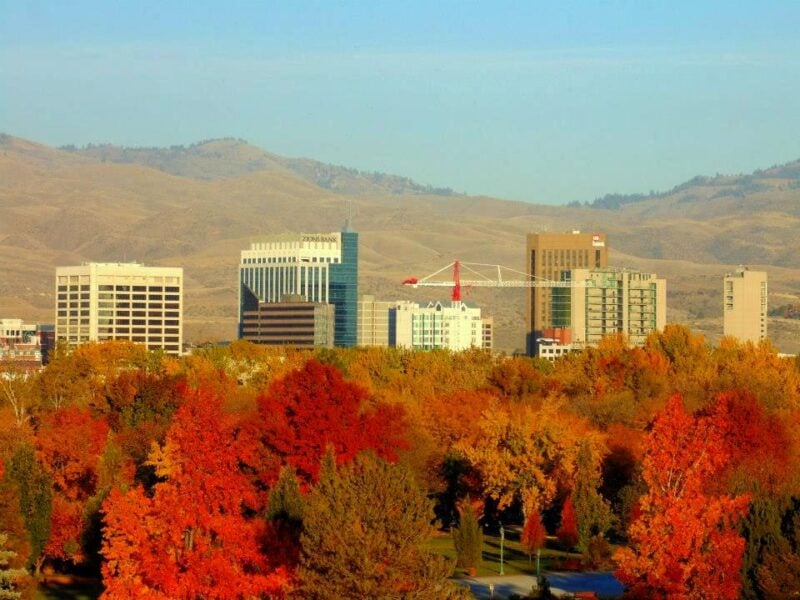
Boise stands as Idaho’s capital city and largest metropolitan area. The city sits in the Treasure Valley region of the Snake River Plain.
The local economy offers a strong job market across multiple industries. Residents benefit from relatively affordable housing costs compared to other western cities.
Boise provides extensive outdoor recreation opportunities within city limits. The area features thousands of acres of protected reserves and foothills access. Julia Davis Park offers green space in the urban core.
The city maintains low crime rates and family-friendly neighborhoods. Public schools serve the community alongside higher education institutions.
Boise’s location provides four distinct seasons with generally dry weather conditions. Winter brings moderate snowfall while summers remain warm and sunny.
The metropolitan area includes nearby communities like Meridian, Eagle, and Nampa. These suburbs offer additional housing options within commuting distance of downtown Boise.
Key Factors That Make Idaho’s Cities Desirable
Idaho’s cities attract residents through a combination of affordable housing costs, abundant outdoor recreation access, growing employment opportunities in technology and healthcare, and strong community-focused lifestyles. These elements create appealing environments for families, young professionals, and retirees alike.
Affordability and Cost of Living
Housing costs in Idaho remain significantly lower than in neighboring states like Washington and California. The median home price varies by city, with smaller communities offering particularly affordable options for first-time buyers.
Utility costs stay reasonable due to Idaho’s hydroelectric power generation. Property taxes rank among the lowest in the nation, making homeownership more accessible for middle-income families.
Cost advantages include:
-
Lower housing costs than West Coast cities
-
Reduced property tax burden
-
Affordable utilities from renewable energy sources
-
Lower overall living expenses
Grocery and transportation costs remain below national averages in most Idaho cities. This affordability allows residents to maintain higher disposable income while enjoying quality amenities and services.
Outdoor Recreation Opportunities
Idaho’s geography provides year-round outdoor activities within short distances of major cities. The state contains extensive wilderness areas, mountain ranges, and river systems that support diverse recreational pursuits.
Winter sports flourish with multiple ski resorts and backcountry access. Summer activities include hiking, fishing, camping, and water sports on lakes and rivers throughout the region.
Popular activities include:
-
Skiing and snowboarding at Sun Valley and Brundage Mountain
-
Hiking in Sawtooth National Recreation Area
-
Fishing on Snake River and Lake Coeur d’Alene
-
Mountain biking on extensive trail systems
Cities like Boise offer urban trail networks connecting to wilderness areas. This accessibility allows residents to engage in outdoor activities during lunch breaks or after work without extensive travel.
Employment and Economic Growth
Technology companies have established significant operations in Idaho, creating high-paying jobs in software development and manufacturing. Major employers include Micron Technology, which anchors the state’s technology sector.
Healthcare systems continue expanding to serve growing populations. Education sectors provide stable employment opportunities in both K-12 and higher education institutions.
Manufacturing remains strong with food processing, lumber, and mining operations. Key economic sectors:
-
Technology and semiconductor manufacturing
-
Healthcare and medical services
-
Education and government
-
Agriculture and food processing
Boise’s job market particularly benefits from corporate relocations and startup activity. Unemployment rates consistently track below national averages across most Idaho cities.
Community and Lifestyle
Idaho cities maintain small-town atmospheres despite population growth. Residents often cite strong neighborhood connections and community involvement as major lifestyle benefits.
Cultural amenities include museums, theaters, and festivals that reflect both western heritage and contemporary interests. Downtown areas in cities like Boise and Coeur d’Alene feature walkable districts with local businesses.
Safety levels remain high with crime rates below national averages in most communities. School systems generally receive good ratings, making these areas attractive for families with children.
Traffic congestion stays minimal compared to larger metropolitan areas. Commute times remain short, allowing more time for family activities and personal interests.
Quality of Life Considerations When Choosing a City
Several critical factors determine how comfortable and fulfilling life will be in any Idaho city. Education quality, healthcare availability, and safety levels directly impact daily living experiences and long-term satisfaction.
Education and Schools
Idaho’s education system varies significantly between urban and rural areas. Boise and Meridian offer the strongest public school districts with higher graduation rates and more advanced placement courses.
Key Education Metrics:
-
Student-teacher ratios range from 18:1 in larger cities to 14:1 in smaller communities
-
Test scores typically rank higher in districts like West Ada and Boise
-
College preparatory programs are most abundant in metropolitan areas
Rural districts often provide more personalized attention but may lack specialized programs. Many smaller Idaho cities compensate with strong community college partnerships and vocational training opportunities.
Private school options concentrate primarily in Boise, Coeur d’Alene, and Idaho Falls. Homeschooling rates in Idaho exceed the national average across all regions.
Healthcare Access
Healthcare availability creates stark differences between Idaho’s urban centers and rural communities. Boise and Idaho Falls provide comprehensive medical facilities including specialized care and emergency services.
Major Healthcare Systems:
-
Saint Alphonsus – Multiple locations statewide
-
St. Luke’s Health System – Primarily southwestern Idaho
-
Kootenai Health – Northern Idaho coverage
Smaller cities like Twin Falls and Pocatello maintain regional medical centers serving surrounding areas. Rural communities often rely on critical access hospitals with basic services.
Specialist availability becomes limited outside major metropolitan areas. Travel distances for advanced care can exceed 100 miles in remote locations.
Mental health services remain particularly scarce in rural Idaho counties.
Safety and Crime Rates
Idaho consistently ranks among America’s safest states with violent crime rates well below national averages. Property crime varies more significantly between communities.
Crime Rate Patterns:
-
Violent crime: 2.4 per 1,000 residents statewide
-
Property crime: Higher in tourist areas and college towns
-
Rural areas report the lowest overall crime statistics
Cities like Meridian and Post Falls maintain exceptionally low crime rates. Boise experiences higher property crime due to population density but remains relatively safe.
Drug-related crimes concentrate in specific neighborhoods within larger cities. Emergency response times vary dramatically between urban and rural locations.
Most Idaho communities benefit from strong neighborhood watch programs and community policing initiatives.





